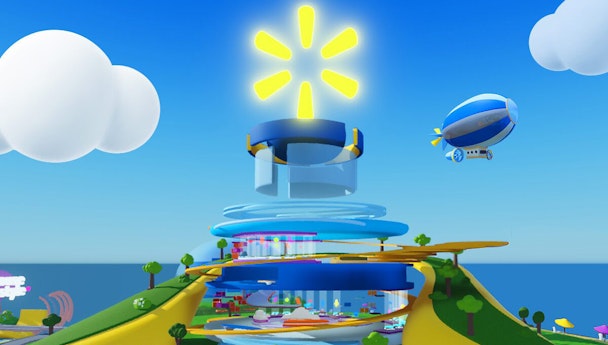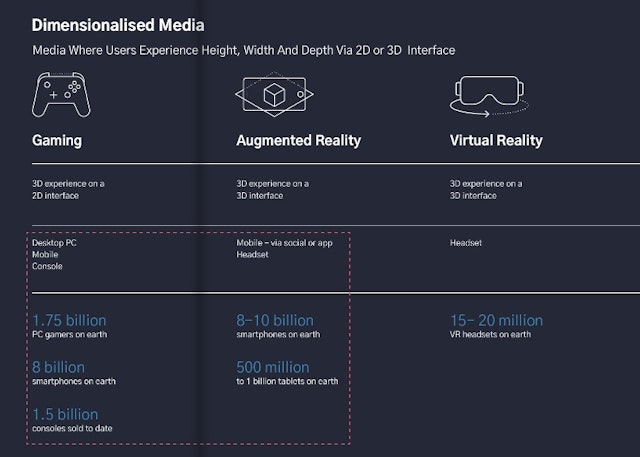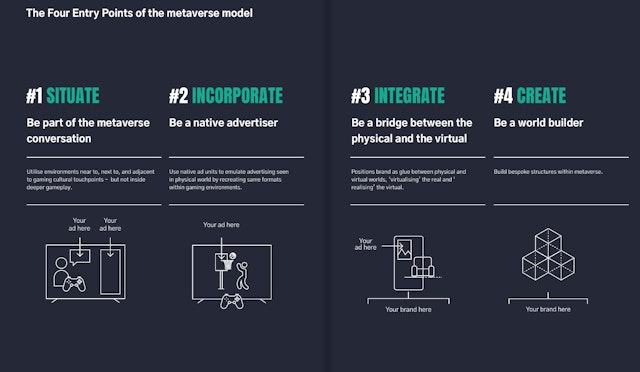OMG is on a mission to rescue marketers from the ‘regretaverse’
Marketers have been so obsessed with the incorporeal promises of what the metaverse could be, they’re missing what’s available today says futurist Phil Rowley.

Omnicom rails against the 'Regretaverse' to offer sensible alternatives
As Omnicom Media Group releases a report debunking misconceptions about the sector, its head of futures, Phil Rowley, tells The Drum: “We wanted to correct the feverish overreaction of some brands and business and clients”.
Having spent a year studying the market, he has identified many false ideas of what the metaverse is. He puts them in three buckets.
Advertisement
1. Constricted: Often the metaverse is tied to a single piece of tech, usually by the business selling said tech. This is a constricted definition. Meta is the most obvious example, positioning it as a VR haven. We don’t really know how it will form.
Rowley explains: ”We’ve seen a lot of commentaries that confuse or conflate the metaverse with VR, and also conflate the metaverse with just a series of gaming titles that just happen to be popular: Roblox and Minecraft.”
2. Convoluted: While some pinpoint a specific piece of tech others get bogged down in some of science fiction writer and futurist Neal Stephenson’s ideas. For example, it may be too much to ask competing web giants to create an interoperable web3. Surely that alone doesn’t mean we'll never form a metaverse?
“Some definitions go way too much into the engineering technicalities. They’re obsessed with the fact that it is synchronous and pervasive. But are there any definitions that we find useful to brands right now?”
These technicalities don’t matter to audiences.
Advertisement
3. Quixotic: Another thing that's made the exuberant boom of metaverse thinking hard to criticize is that many descriptions are “implausible, romanticized and idealistic”.
Rowley says: “There are many people in this field who will wax lyrical about how we’re all going to be living in the metaverse Ready Player One-style by the end of next week. It is totally, utterly unhelpful.”
A dose of reality is needed, he explains. Helpfully, he’s out to deliver it.
So what is the metaverse?
Rowley found it easier to say what it isn't than what it is. As a proper futurist, he’s not into predictions, he’s more about charting the direction of travel rather than the destination. His definition is created for brands curious about the metaverse, and it's worth remembering that it is coming from one of the world's biggest media agencies, so with that lens caveated here’s what he says.
“It’s a conflagration of two technologies, one is the internet which brought this idea of connectivity or digital connectedness and network knowledge. And secondly, gaming, dimensionalized media.”
Rowley has carefully brought us to online gaming, which today is the closest we have to any supposed metaverse. But he’s not saying it is the metaverse, he’s excited by the tech underpinning worlds like Fortnite, Minecraft and more.
He points out that gaming introduced a Z-axis to media, a 3D perspective, albeit through a 2D interface (a screen). Those on the Nintendo 64 or PlayStation 1 generation will remember how revolutionary that was when it was introduced to gaming. OMG’s metaverse model is preparing brands for a faster, more powerful 3D internet. Long-time users may scoff, but Gen-Z may well take to it more naturally, that’s what’s being planned for.
Rowley then goes into the four ways that brands can activate towards, if not in, the metaverse, like an on-ramp of options where reach decreases as complexity increases.
Suggested newsletters for you
1. Situate: As a futurist at a media agency, it’s no surprise he’s urging us to start with media that exists. But while it exists, brands may not be aware that they can talk to the supposed metaverse audiences today. They often mean gaming audiences, which globally is now technically between one billion and three billion people, depending on your definition. However, even now, that label still carries a stigma – despite the average UK gamer being 35, the gender split is fairly even. Over 60 gamers clock in more than 20 hours a week. “Gaming is as wide as any other medium now.”
Brands don’t need to be ‘in’ games to get gamers. YouTube Gaming had 1.13bn hours of viewing, viewing in the last quarter on gaming content. Twitch streamed 1tn minutes in 2022, and that’ll continue (if it doesn’t continue to upset creators). They are reachable with banner ads, pre-rolls and more through gaming-adjacent content.
It’s a way to start taking to what will most likely be the key metaverse demographic. And he chucked in that brands can do that using existing assets. While agencies go on about authenticity in gaming, it’s not so important at this stage, he believes. It’s best to turn up and start making those connections. The brands advertising around Coronation Street (a beloved UK soap) don’t have to make their ads themed around the show. Gaming isn’t different.
2. Incorporate: This is the stage where things start coming closer to the metaverse experience many have touted. Many call this opportunity in-game advertising or virtual out-of-home.
It’s about taking real-world ads, be it outdoor or radio, for example, and incorporating it into an existing world or video game. Huge progress has been made in this space and brands can now prove ad viewability in 3D spaces.
It’s going to be a staple of any media plan in a few years. To many, it will be the metaverse fully realized.

3. Integrate: Now this is a younger opportunity and it’s about overlapping the digital and physical. Rowley is excited by the “forgotten half of the metaverse”, augmented reality (AR).
Rather than talking the real into virtual worlds, what if the real potential was in taking the virtual into the real world? It’s something that Pokemon Go raised awareness of half a decade ago. Filters and experiences in social apps like Snap and TikTok or now managing to bring it into the mainstream. Brands struggle to understand the value these bring to the media plan, but it’s clear the potential is huge. Rowley says: “The metaverse technically exists in the real world too. There are plenty of opportunities that brands have used already used.”
4. Create: And here is the final tier of metaverse activation and it’s the one that most people fixate on, erroneously, according to Rowley. It’s also the hardest part.
This is the “quickest route to that ‘Regretaverse’... a virtual zone of disappointment led by people who really, you know, had perhaps overestimated their ambitions or misunderstood the size of the entire territory.”
He points to the EU’s botched rave party costing €387,000 and attracting six visitors, dubbed by the body as ‘digital garbage’.
I’m here at the “gala” concert in the EU foreign aid dept’s €387k metaverse (designed to attract non politically engaged 18-35 year olds — see story below). After initial bemused chats with the roughly five other humans who showed up, I am alone. https://t.co/ChIHeXasQP pic.twitter.com/kZWIVlKmhL
— Vince Chadwick (@vchadw) November 29, 2022
Building a scalable experience or game is hard. It’s something most video game companies fail to do. It’s highly improbable a brand can build its own platform and hit any respectable KPIs at this stage. It’s why they prefer to piggyback existing platforms, be it games or social apps, to launch experiences.

So where does that leave the metaverse?
So there’s the balance between the opportunities that exist and are easily accessible with existing ad creative and the first-mover advantage and PR lift of being seen to be innovating spaces that resemble what some call the metaverse.
When picking where to land a campaign, Rowley asks clients to consider what they would do if TV were to be invented yesterday. Clients would approach him and say something along the lines of: ‘We really need to start using TV in our media plan.’
Would the client be happy building a TV studio, channel infrastructure and running that on the air, rather than finding the media opportunities inherent in TV? “If you think ‘build it and they will come’, the road tends to lead to disappointment,” Rowley says.
And that has been exhibited in the user numbers of some of the branded experiences that have been launched over the last few years.
Citing the Gartner Hype Cycle, he says: “We’re about to go down into the trough of disillusionment and the peak of inflated expectations. Over time, it will find its level back into the plateau of productivity.”
Brands that are just chasing the hype should look elsewhere. The metaverse needs to be built, which will require years of testing and learning.
If The Drum readers think of the metaverse as a poorly rendered virtual store, he’ll have “failed” in his mission. Few brands will ever pull off an experience like that, Lego in partnership with Epic perhaps. But, Greggs the bakery, he says for example, probably not. Most will be running a “deserted virtual mall.”
If clients are dead-set on going down the ‘Create’ route, they should build an experience people would actually seek out, before stocking up the virtual shelves.
But as it is, such activities are “dragging the center of gravity” away from the easy media opportunities in gaming, It won’t “win you a Cannes Lion” but it will build a relationship with a digitally-savvy crowd. And that’s the first step to acceptance in the metaverse, whatever form that and the next version of the internet looks like.
You can download the full report here. Let us know your thoughts by tagging @The Drum and Rowley on LinkedIn. And don’t forget to sign up to the Media Agency Briefing for a weekly update on the biggest questions facing the industry.

